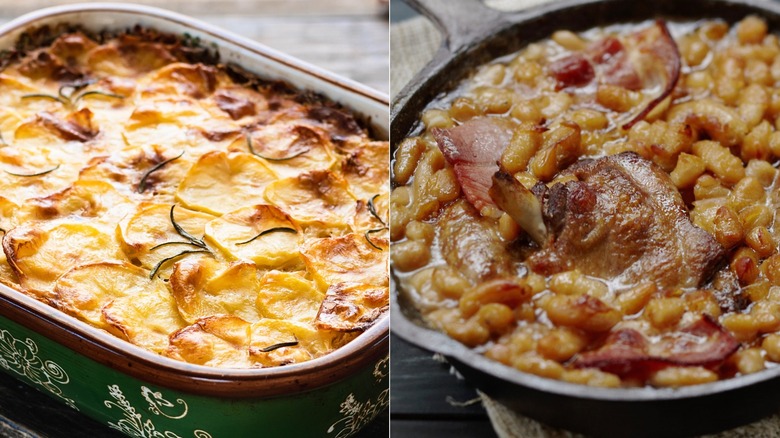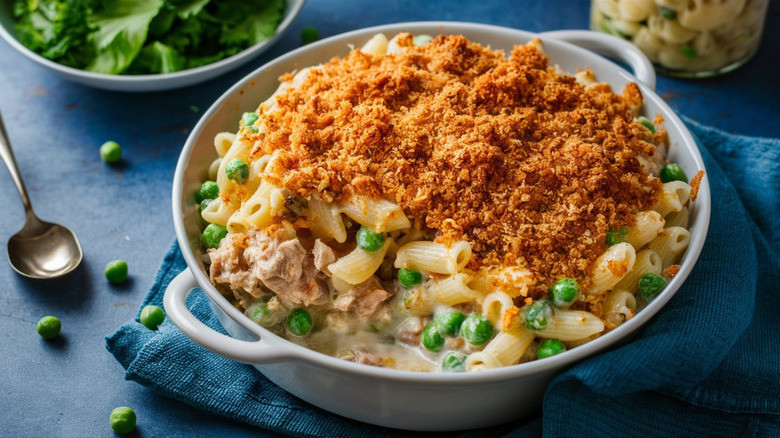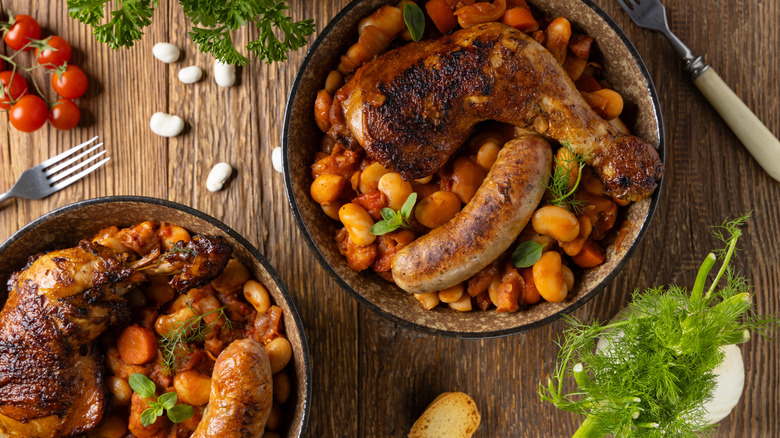Casserole Vs Cassoulet: What's The Difference?
At one point in their lives, most people have prepared or eaten a casserole, whether it's the green bean casserole your aunt brings every Thanksgiving or the loaded beef taco casserole you gobbled at your last in-office potluck. But it's not everyday one gets to enjoy cassoulet. Casserole, cassoulet ... it's a tomato, tomato type scenario, right? Well, no. Though the words sound similar, the dishes themselves are really quite different. A casserole is a category of food made in a deep pan or bowl, also called a casserole dish, which is baked in the oven.
Conversely, cassoulet is a specific dish said to originate in Castelnaudary, France, in the mid-14th century during the Hundred Years' War. Although it contains ingredients considered expensive to the average consumer, it's often referred to as a rustic dish made with white beans, mirepoix veggies, and several different types of meat, including (but not limited to) confit duck legs, pork sausage, and bone-in lamb stew meat.
What is a casserole?
While the word casserole is French in origin, meaning saucepan, it's also a type of one-pan dish made for centuries all over the world. It is thought to have been adopted in the U.S. in the early 1800s and appeared in Mary Randolph's (Thomas Jefferson's daughter) cookbook "The Virginia Housewife" published in 1824. Since its inception in Randolph's kitchen, the American casserole has been a cost-saving dish, one that can be made quickly and inexpensively to easily feed a growing family.
The casserole we know today is essentially the same: a one-pan creation typically made with vegetables, meats, and grains such as pasta or rice, baked and divided or sliced into easily-doled out portions. One only has to recall an evening at the Cleaver's or Brady's to evoke an image of a large family sitting around a steaming, golden-topped casserole fresh from the oven. Specific recipes such as a creamy, cheesy tuna casserole or chicken tetrazzini come to mind when describing the dish, but the casserole has evolved to include all manner of meals, from breakfasts to sides, and even desserts.
What is cassoulet?
Though it would be a stretch, you could say cassoulet is a one-pot meal, but even if you have many of the ingredients already prepared, it requires both time and patience. Originating in the rural kitchens of France, cassoulet was traditionally made by farm wives with easy access to ingredients like duck confit, freshly butchered pork or lamb, and rendered lard, which aren't as readily accessible to the modern home cook.
Easily a two or three-day process, cassoulet is expensive and labor-intensive, even if you happen to have some duck confit or garlic sausage on hand. The beans need to soak and the stew meat (lamb and pork) should marinate in garlic, cloves, thyme, and rosemary overnight. The next morning you roast the marinated stew meat in duck fat or lard for several hours while you prepare the beans and vegetables — which must also be simmered for several hours. The result is a "stew" or bean and meat confit creation considered an icon of French home cooking. If you ever get a chance to enjoy cassoulet, you'll know (likely before the first morsel touches your lips) that it's definitely not a casserole.


